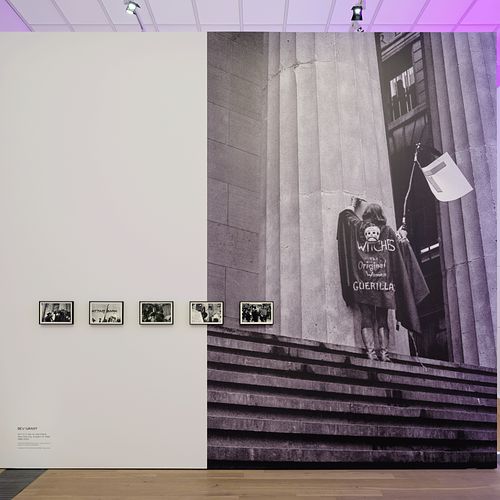AUDIO
Bev Grant / W.I.T.C.H.
Halloween, 1968. Women with long cloaks, masks, and signs are standing in a group—they are on the steps of Federal Hall on Wall Street in New York City. They chant spells, dance, and hand out fliers. And they cast curses on the financial center and the banks of New York.
What looks like a ritual was actually a political demonstration. The group called themselves W.I.T.C.H.—Women’s International Terrorist Conspiracy from Hell. One of the members, Bev Grant, a photographer, musician, and activist, was right in the thick of the action. She captured the scenes of that day in striking black-and-white photographs.
The pictures you see here do not show fairy-tale witches. Instead, they show women who appropriate the figure of the witch—as a symbol of resistance and freedom. Witches, after all, were always more than just fantastical characters. They were women who refused to submit. They had knowledge, healed, made decisions. They didn’t fit into the system, and were therefore seen as a threat. And for precisely this reason they were persecuted.
The group called W.I.T.C.H. built on this history and turned persecution into protest. The activists deliberately portrayed themselves as modern witches—wild, discomfiting, loud. They directed their criticism at patriarchal and capitalist structures. Against a system that controls and excludes women and the queer community.
The protest was more than just a moment in time. It marked a beginning. Other groups formed in Chicago and in Washington, DC, and later in Boston and in Portland, Oregon. To this day, the witch continues to appear in feminist movements—as a figure poised between myth and power.
Bev Grant’s photos show how images can convey political messages. How we can continue to write history—with masks, with words, with bodies.
You may ask yourself: How does this relate to the present day? Look at the capes, the slogans, the participants’ postures. And then think about current protests. The witches are back. And they still have a lot to say.
What looks like a ritual was actually a political demonstration. The group called themselves W.I.T.C.H.—Women’s International Terrorist Conspiracy from Hell. One of the members, Bev Grant, a photographer, musician, and activist, was right in the thick of the action. She captured the scenes of that day in striking black-and-white photographs.
The pictures you see here do not show fairy-tale witches. Instead, they show women who appropriate the figure of the witch—as a symbol of resistance and freedom. Witches, after all, were always more than just fantastical characters. They were women who refused to submit. They had knowledge, healed, made decisions. They didn’t fit into the system, and were therefore seen as a threat. And for precisely this reason they were persecuted.
The group called W.I.T.C.H. built on this history and turned persecution into protest. The activists deliberately portrayed themselves as modern witches—wild, discomfiting, loud. They directed their criticism at patriarchal and capitalist structures. Against a system that controls and excludes women and the queer community.
The protest was more than just a moment in time. It marked a beginning. Other groups formed in Chicago and in Washington, DC, and later in Boston and in Portland, Oregon. To this day, the witch continues to appear in feminist movements—as a figure poised between myth and power.
Bev Grant’s photos show how images can convey political messages. How we can continue to write history—with masks, with words, with bodies.
You may ask yourself: How does this relate to the present day? Look at the capes, the slogans, the participants’ postures. And then think about current protests. The witches are back. And they still have a lot to say.
